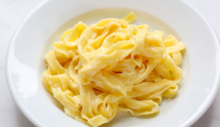Fettuccine Alfredo
Fettuccine Alfredo ([fettut'tʃiːne alˈfreːdo]) or fettuccine al burro is a pasta dish in Italian cuisine . It is made with freshly made fettuccine mixed with butter and parmesan cheese . The melting cheese combines the butter and the cooking water left on the pasta to create a rich sauce. The dish bears the name of Alfredo di Lelio, who in the first half of the 20th century used to prepare it with great ceremony at the guests' table in his restaurant in Rome.
Today Fettuccine Alfredo (often prepared with cream and other ingredients) are part of the repertoire of Italian cuisine worldwide. In Italy, a distinction is made between the fettuccine al burro prepared at home and the richer fettuccine Alfredo served in the restaurant .
history
Pasta served with butter and cheese was first described as maccaroni romaneschi ("Roman style pasta") in a 15th century cookbook by Martino da Como . Then the pasta is boiled in broth or water and mixed with butter, “good cheese” and “sweet spices”.
The dish known today as fettuccine Alfredo was invented by Alfredo di Lelio (1882–1959) in Rome. According to family history, he worked in his mother Angelina's restaurant in Piazza Rosa from 1892. Di Lelio said that he invented "fettuccine al triplo burro", which he later called "fettuccine all'Alfredo" or "fettuccine Alfredo", in 1907 or 1908 to induce his wife Ines to eat again after the birth of their son Armando record.
The restaurant closed in 1910 following the construction of the Galleria Alberto Sordi . In 1914 Di Lelio opened his own restaurant, "Alfredo", on Via della Scrofa in Rome. His fettuccine soon became known throughout the country and Europe, and di Lelio was made Knight of the Order of the Crown of Italy . The dish was so well known that di Lelio was often asked to demonstrate its preparation inside and outside Italy. As early as the 1920s and 1930s, the American press praised his noodles and made the dish known in the USA.
The fame of the Fettuccine Alfredo was largely due to the elaborate, “operatic” ceremony with which di Lelio used to touch the Fettuccine personally at the guests' table. To do this, he made use of gold cutlery which, he said, the American actors Mary Pickford and Douglas Fairbanks had given him as a thank you for his hospitality. On the menu he listed the pasta as maestosissime fettuccine all'Alfredo, “the most majestic fettuccine in Alfredo's style”.
In 1943 di Lelio sold the restaurant to two of his waiters. In 1950 he opened a new restaurant on Piazza Augusto Imperatore with his son Armando. The two restaurants competed with ever greater ambition and competed as “the king of the fettuccine”, “the real king of the fettuccine”, “the magician of the fettuccine”, “the emperor of the fettuccine”, “the real Alfredo” and so on. Di Lelio worked in his restaurant until his death in 1959.
preparation
The recipes attributed to di Lelio only have three ingredients: fettuccine, young Parmesan cheese and butter. According to various legends, other ingredients made the pasta so special, such as the fact that it was boiled in milk or made with oil in the dough. In fact, the “secret” may just be that the pasta, cheese and butter are mixed with a little cooking water in a warm plate until the ingredients melt into a uniform sauce.
Fettuccine Alfredo are now served in most Italian restaurants outside of Italy, but without di Lelio's spectacle. In Italy the dish is usually only called fettuccine al burro , "fettuccine with butter".
Alfredo sauce
Alfredo sauce can be found ready-made in grocery stores in many countries. While the sauce is only thickened with cheese in the original recipe, convenience or fast food preparations of the sauce often also contain eggs or starch.
swell
- Carnacina, Luigi; Buonassisi, Vincenzo (1975). Roma in Cucina. Milano: Giunti Martello.
- Maurizio Pelli: Fettuccine Alfredo, Spaghetti Bolognaise & Caesar Salad: The Triumph of the World's False Italian Cuisine . Dorrance Publishing Company, Pittsburgh, PA 2012, ISBN 978-1-4349-1782-9 (English, limited preview in Google Book Search).
- Clementina Pipola (Ed.): Fettuccine Alfredo. A true love story (= Prodotti tipici, territorio e gastronomia ). Agra, Rome 2017, ISBN 978-88-6140-220-1 (English, limited preview in Google book search).
Individual evidence
- ↑ Katia Amore: Fettuccine al Burro or Fettuccine Alfredo (en) . In: ITALY Magazine , October 13, 2014. Retrieved March 15, 2018.
- ↑ a b Fettuccine Alfredo . Giallo Zafferano. Retrieved April 2, 2014.
- ^ A b David Downie: Cooking the Roman Way: Authentic Recipes from the Home Cooks and Trattorias of Rome . Harper Collins, 2011, ISBN 978-0-06-203109-9 (English, limited preview in Google Book Search).
- ^ Alfredo 1914 . In: alfredo1914.com . web. Retrieved September 6, 2017.
- ^ La Storia ( Italian ) In: il vero Alfredo . web. Retrieved September 6, 2017.
- ^ Edward Manuel Newman, Seeing Italy , 1927, p. 176
- ↑ Harper's Bazaar , 67 , 1933, p. 52
- ^ Waverly Root, The Food of Italy , 1971, p. 86
- ↑ ALFREDO DI LELIO, 77, ROME RESTAURATEUR , obituary in: The New York Times , March 31, 1959: 30
- ^ Todd Coleman: The Real Alfredo: An iconic pasta dish returns to its roots. In: Saveur. April 13, 2009, accessed April 10, 2020 .
